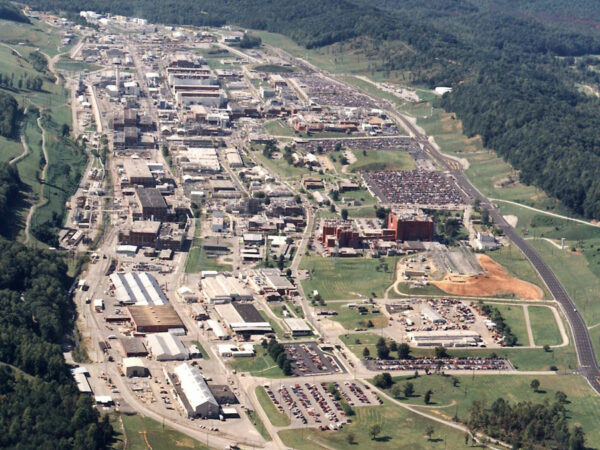Y-12 Plant

“Birth Place of the Atomic Bomb”
Atomic History
Shortly before US involvement in WWII, the US government began operations to produce the vital elements needed to make a new kind of weapon: the atomic bomb. This was in response to fears that scientists in Nazi Germany were also working towards the development of atomic weapons. This highly secretive effort was later referred to as the Manhattan Project, which operated in three primary locations: Hanford, Washington, Los Alamos, New Mexico, and Oak Ridge, Tennessee. Additionally, there were other infrastructure sites that supported the mining of uranium, the extraction of plutonium from uranium, and the production of uranium-235 — an isotope comprising less than 1% of naturally occurring uranium, through enrichment.
The area and city known today as Oak Ridge, Tennessee was selected as a production site in September of 1942. In February 1943, construction began on a planned city and industrial complex that would eventually cover 90 square-miles. Within Oak Ridge, the electromagnetic isotope separation facility codenamed Y-12, a complex comprising 270 buildings, housed the operation and workers tasked with enriching uranium.
At its peak, Y-12 employed over 22,000 men and women. Jobs at the plant included research and development, manufacturing, production, laboratory work, and support.
After the production of the materials for the first atomic bombs during WWII, the missions of the Y-12 National Security Complex, as it came to be known, were to:
- Maintain safety and security of nuclear weapons stockpile
- Reduce global threat of nuclear war and terrorism
- Provide feedstock or stockpile to fuel the US nuclear Navy
Mission 1: Maintain safety and security of nuclear weapons stockpile
There were four main components to this mission; production, surveillance testing, disassembly, and storage. Production involved the making of new elements, as well as a process called refurbishment, that combined new components with recycled materials. Surveillance testing was used to monitor how weapons in the stockpile were aging and disassembly separated materials of retired weapons and recuperating their nuclear parts.
Mission 2: Reduce global threat of nuclear war and terrosim
Along with the removal and security of nuclear materials, undertakings to reduce the global threat of nuclear war included making certain weapons material available for non-war uses, such as fueling nuclear research reactors and the production of medical components. The Y-12 Complex works closely with the National Nuclear Security Administration (NNSA) along with other federal agencies to securely protect and guard nuclear materials. Through NNSA’s Office of Material Management and Minimization, Y-12 secures and transports materials for safe storage or disposal.
Mission 3: Provide stockpile to fuel the US Nuclear Navy
In an agreement with NNSA’s Naval Reactors Office, Y-12 has, and will continue their endeavor to provide highly enriched uranium (stockpile) to fuel the US Navy’s nuclear powered aircrafts and submarines. In addition to assisting the Nuclear Navy, Y-12 will soon be able to use nuclear weapons stockpiles to replace conventional x-rays.
Little Boy
The ending of World War II was largely credited to the dropping atomic bomb, “Little Boy” over Hiroshima, Japan on August 6th, 1945. However, production of the atomic weapon required uranium-235, a highly enriched uranium, and a significant element needed to properly detonate the weapon. Since uranium-235 makes up only 1 part in 140 of natural uranium, necessary enrichment of the uranium was performed at the Y-12 National Security Complex. The first 200g shipment of highly enriched uranium was sent to the Los Alamos Laboratory, where the rest of production took place, in June 1944.
Today, Y-12 continues to bolster national security today as a one-of-a-kind industrial asset in the production, processing, and storage of defense related materials. It continues its responsibility for stewardship of nuclear materials stockpile and also assists in nuclear non-proliferation.
Sources
To read the full article, check out our Fall 2022 Atomic Health News edition
Did you work at Y-12?
We Can Help!
For over a decade, we’ve helped former atomic workers, including former Y-12 Plant workers, get connected with and maximize their EEOICPA benefits and receive the quality care services they deserve. We know the EEOICPA inside and out and can help you wherever you’re at in your journey with your benefits!
More than 600,000 former atomic workers across the United States may qualify for up to $400,000 in financial compensation, plus no cost medical benefits for life through the Department of Labor’s EEOICPA.
Connect With Your Local Benefits Specialist
We can help you determine your EEOICPA benefit eligibility, establish your next steps, connect you to resources to help you file your claim, & help you get the most out of your white card benefits.
Phone:
865.444.4043
Office:
1670 Oak Ridge Turnpike
Oak Ridge, TN 37830


